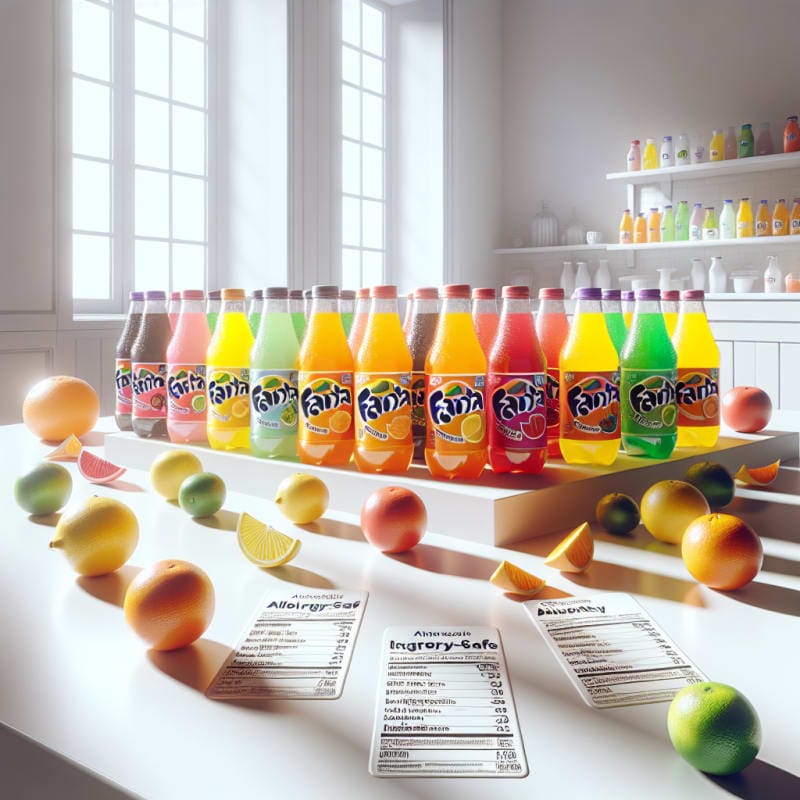Does Fanta Contain Allergens? Ingredient Analysis, Labeling Laws, and Food Scan Genius Does Fanta Contain Allergens? A Comprehensive Guide to Ingredients, Labeling, and Food Sensitivities Category: Lactose / FODMAP / Allergies For consumers navigating food sensitivities, understanding what is in your beverage is essential. This article examines whether Fanta contains allergens, compares regulations across the US and EU, and demonstrates how technology like Food Scan Genius empowers safer choices. Introduction: Why Ingredient Awareness Matters Modern consumers are increasingly vigilant about what they consume, especially when it comes to allergens, lactose, FODMAPs, and other dietary sensitivities. With global brands like Fanta available in over 180 countries, understanding ingredient transparency is not just a matter of curiosity—it is a matter of health and safety. Whether you are lactose intolerant, allergic to specific additives, or simply seeking to avoid certain ingredients, being informed is your first line of defense. Does Fanta Contain Allergens? Quick Answer Q: Does Fanta contain allergens? A: Fanta, in its classic orange variant, generally does not contain the major allergens identified by the FDA or EFSA, such as milk, eggs, peanuts, tree nuts, fish, shellfish, soy, or wheat. However, formulations can vary by country and flavor, and some Fanta products may contain traces of allergens or ingredients of concern for sensitive individuals. Understanding Fanta’s Ingredients: US vs EU Typical Ingredients in Classic Fanta Orange Ingredient US Version EU Version Carbonated Water ✔️ ✔️ High Fructose Corn Syrup / Sugar High Fructose Corn Syrup Sugar (Sucrose) Citric Acid ✔️ ✔️ Natural Flavors ✔️ ✔️ Sodium Benzoate (Preservative) ✔️ ✔️ Food Coloring Yellow 6, Red 40 Beta-Carotene, Carotenes Note: Ingredients may differ for other flavors (e.g., Grape, Lemon, Exotic) and may include additional preservatives, sweeteners, or colorants. Allergen Analysis: What the Science Says Major Allergens: According to the FDA and EFSA, the eight most common allergens include milk, eggs, fish, crustacean shellfish, tree nuts, peanuts, wheat, and soybeans. Fanta does not list these as ingredients in its classic formulation. Artificial Colorants: US Fanta varieties use artificial colorants such as Yellow 6 and Red 40, which have been associated with rare allergic reactions and sensitivities, particularly in children (PubMed). Preservatives: Sodium benzoate, present in most Fanta products, is generally considered safe but may cause reactions in sensitive individuals, especially those with a history of asthma or urticaria (EFSA Journal). Natural Flavors: While labeled as “natural,” these can sometimes be derived from allergenic sources. Manufacturers are required to disclose if they contain any of the major allergens, but cross-contamination is possible. Scientific consensus suggests that for most people, Fanta is free from the primary allergens. However, individuals with sensitivities to additives or rare allergies should remain cautious. FODMAPs, Lactose, and Fanta: Is It Safe? Lactose: Fanta does not contain lactose or dairy-derived ingredients. FODMAPs: Fanta’s main sugars (high fructose corn syrup in the US, sucrose in the EU) are generally considered high-FODMAP, which may trigger symptoms in those with irritable bowel syndrome (IBS) (NCBI). For individuals following a low-FODMAP diet, Fanta may not be the best choice due to its sugar content. Always consult with a healthcare provider for personalized advice. Labeling Laws: US vs EU United States (FDA) Manufacturers must declare the presence of any of the eight major allergens. Artificial colorants and preservatives must be listed by name. “Natural flavors” must be further specified if derived from allergens. European Union (EFSA) 14 allergens must be declared, including celery, mustard, sesame, lupin, and sulfites. Colorants and preservatives are subject to stricter scrutiny. For example, some artificial dyes used in the US are restricted or replaced in the EU (FoodNavigator, 2023). Labels must indicate if any ingredient is genetically modified. These differences mean that Fanta’s ingredient list—and potential allergen risks—can vary significantly depending on where you purchase it. Global Variations: Why Fanta Ingredients Differ Fanta is produced locally in many countries to comply with regional food laws and consumer preferences. For example, the US version often contains high fructose corn syrup and artificial dyes, while the EU version typically uses sugar and natural colorants. Some flavors available in Asia or Latin America may include unique ingredients or sweeteners not found elsewhere (NY Times, 2022). Check local labels: Always read the ingredient list on the packaging in your country. Imported products: Imported Fanta may not comply with local allergen labeling laws. How to Check Fanta for Allergens: Food Scan Genius For those with allergies or dietary restrictions, manually checking every ingredient can be daunting. The Food Scan Genius app (scangeni.us) simplifies this process: Scan the barcode: Instantly access detailed ingredient and allergen information for Fanta and thousands of other products. Personalized alerts: Set your dietary preferences (e.g., lactose-free, low-FODMAP, nut-free) and receive instant warnings if a product contains or may contain allergens. Global coverage: Food Scan Genius recognizes regional variations in labeling and ingredients. User Testimonial: “As someone with multiple food allergies, I never buy a drink without scanning it first. Food Scan Genius caught an ingredient in a Fanta flavor that I would have missed. It’s a lifesaver—highly recommended!” — Maria, Berlin Download Food Scan Genius to take control of your food choices, wherever you are. Recent News: Food Safety and Allergen Awareness “Food Allergy Labeling Laws Expand in 2023” — CNN Health “Calls for Clearer Allergen Warnings on Drinks” — BBC News “EU Tightens Food Labelling Rules to Protect Consumers” — FoodNavigator These developments underscore the importance of vigilance and the role of technology in supporting consumer safety. Frequently Asked Questions (FAQ) Does Fanta contain dairy or lactose? No. Fanta does not contain dairy or lactose in any of its standard formulations. Is Fanta safe for people with nut allergies? Fanta does not contain nuts or nut-derived ingredients. However, always check for cross-contamination warnings. Are artificial colors in Fanta a concern? Some artificial colors (e.g., Yellow 6, Red 40) used in the US have been linked to rare allergic reactions. The EU uses natural alternatives. Can Fanta trigger FODMAP symptoms? Yes, due to its sugar content (especially high fructose corn syrup), Fanta may not be suitable for those on a low-FODMAP diet. How can I check if a Fanta flavor is safe for me? Use the Food Scan Genius app to scan the product and instantly see allergen and ingredient details tailored to your needs. Conclusion: Empowering Informed Choices In a world of complex ingredient lists and evolving food regulations, the question “does Fanta contain allergens?” underscores a broader challenge for consumers everywhere. While Fanta is generally free from major allergens, variations in ingredients and labeling laws across countries mean vigilance is always required. Leveraging technology like Food Scan Genius can transform how you shop, eat, and protect your health. Ultimately, understanding what’s in your food and drink is the most effective way to enjoy them safely—no matter where you are.





